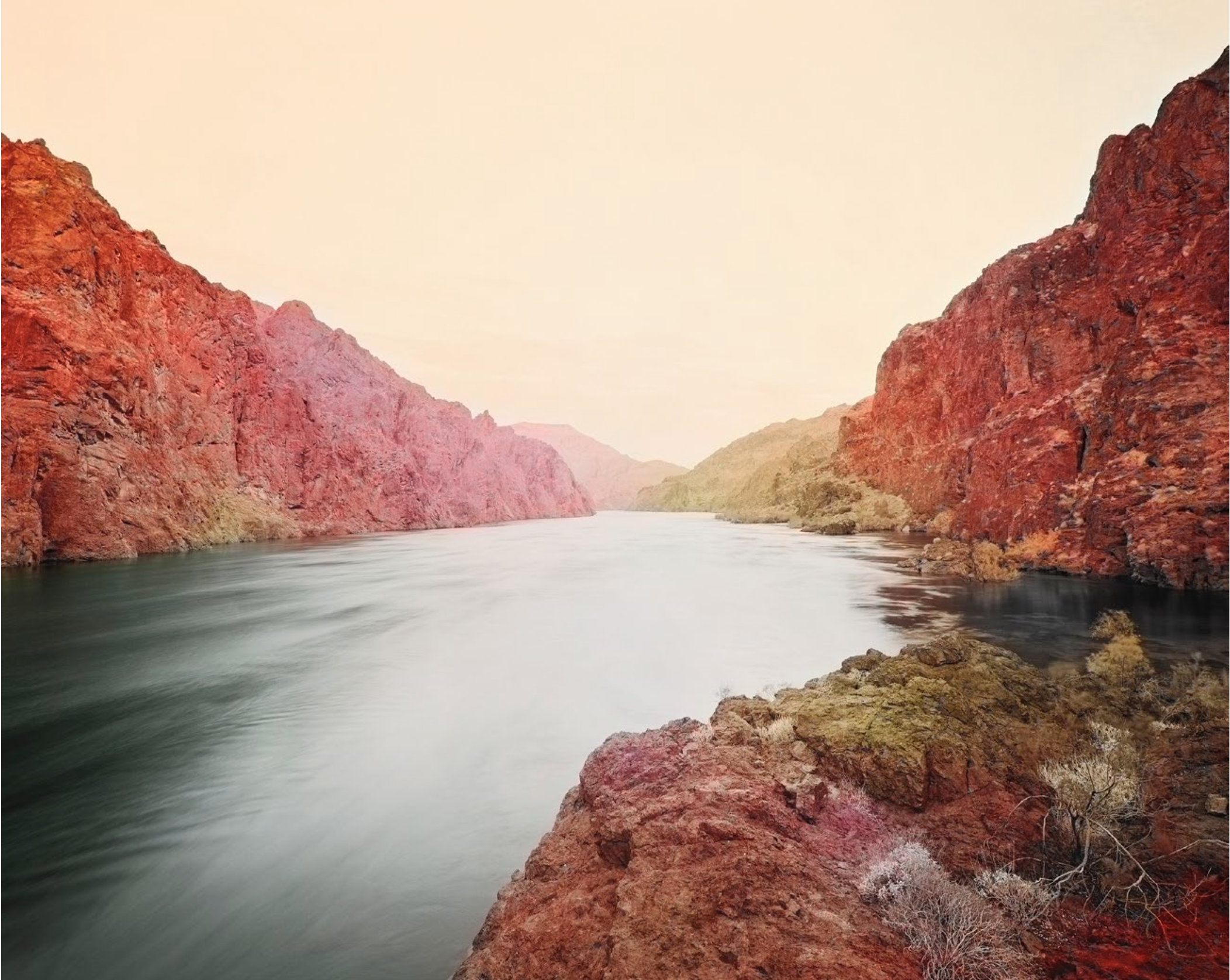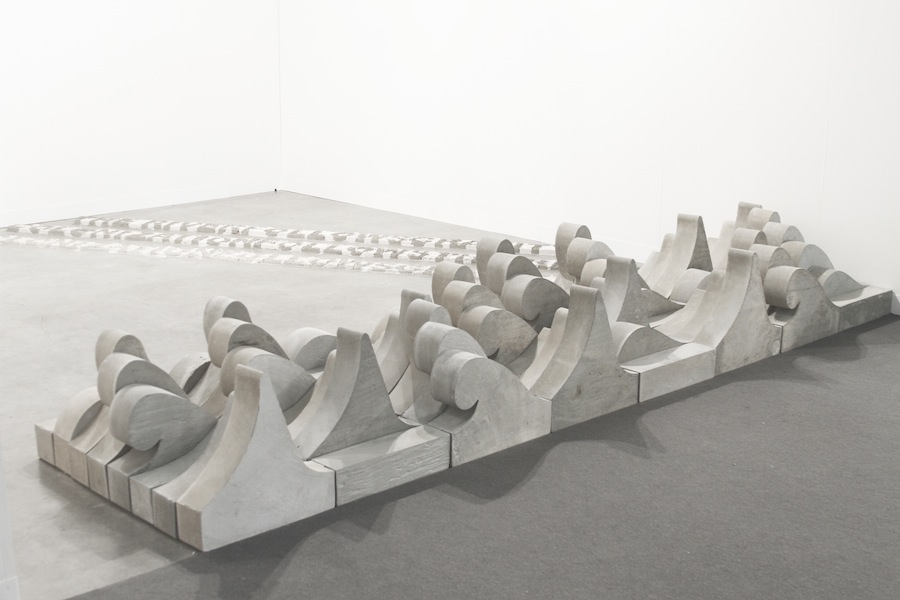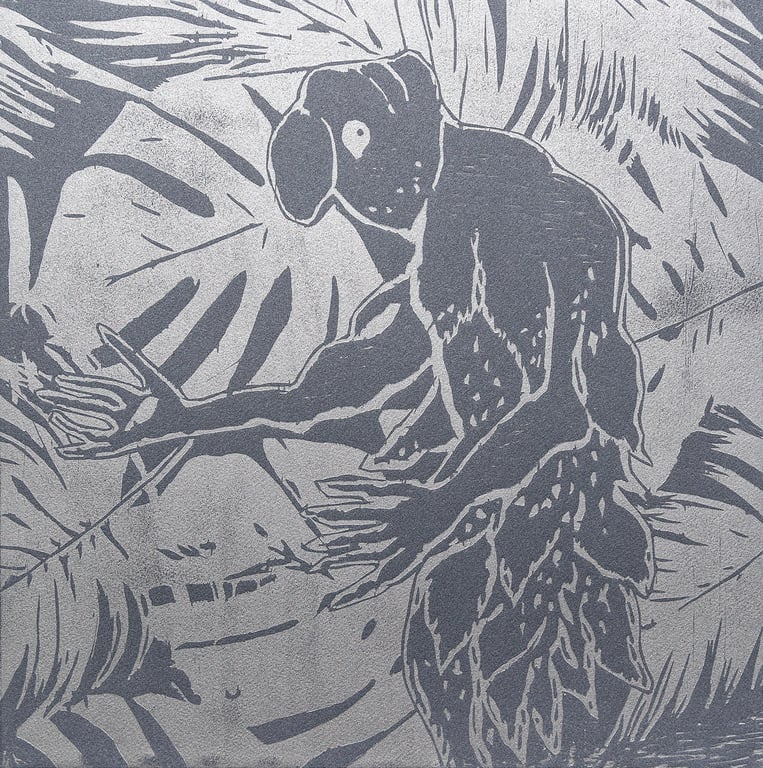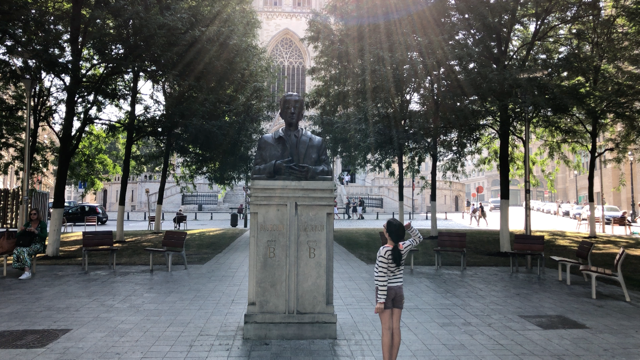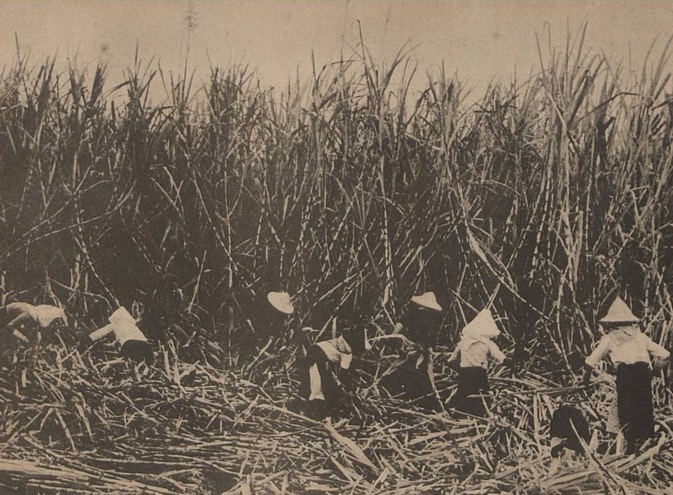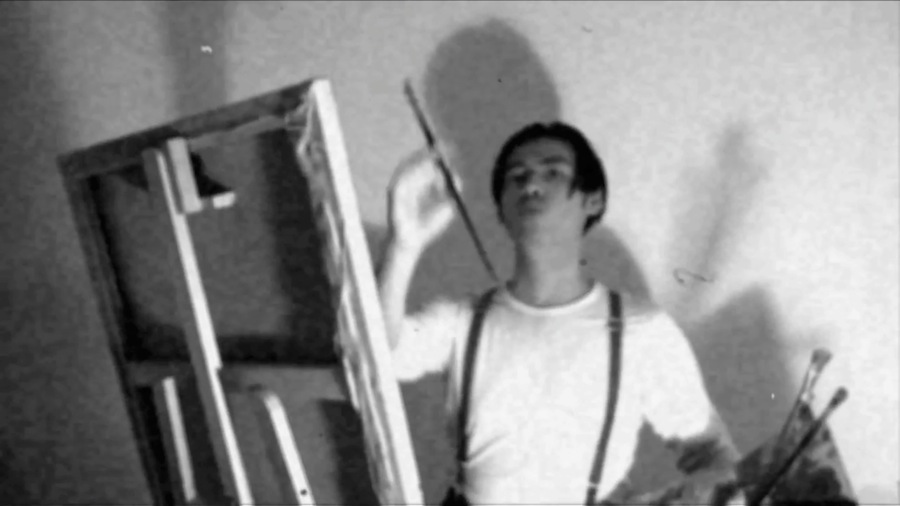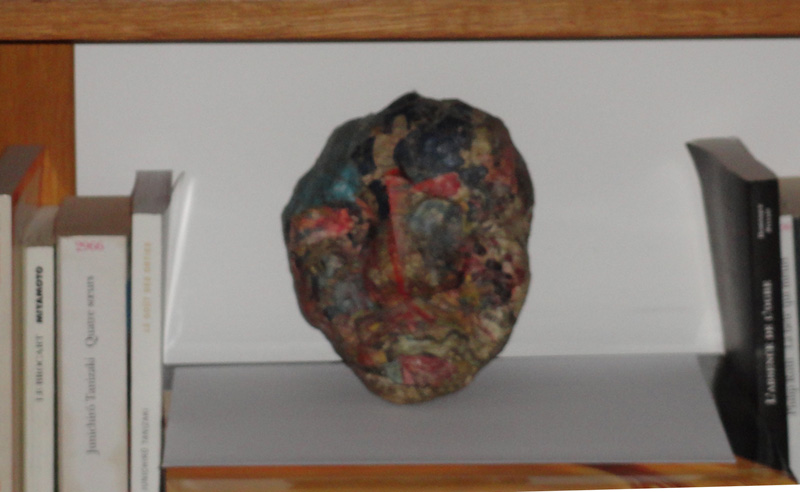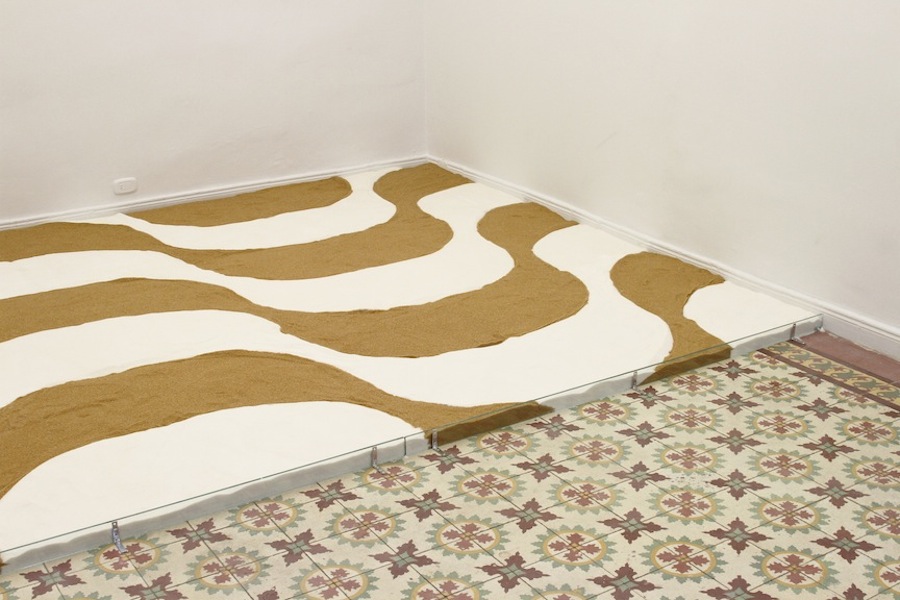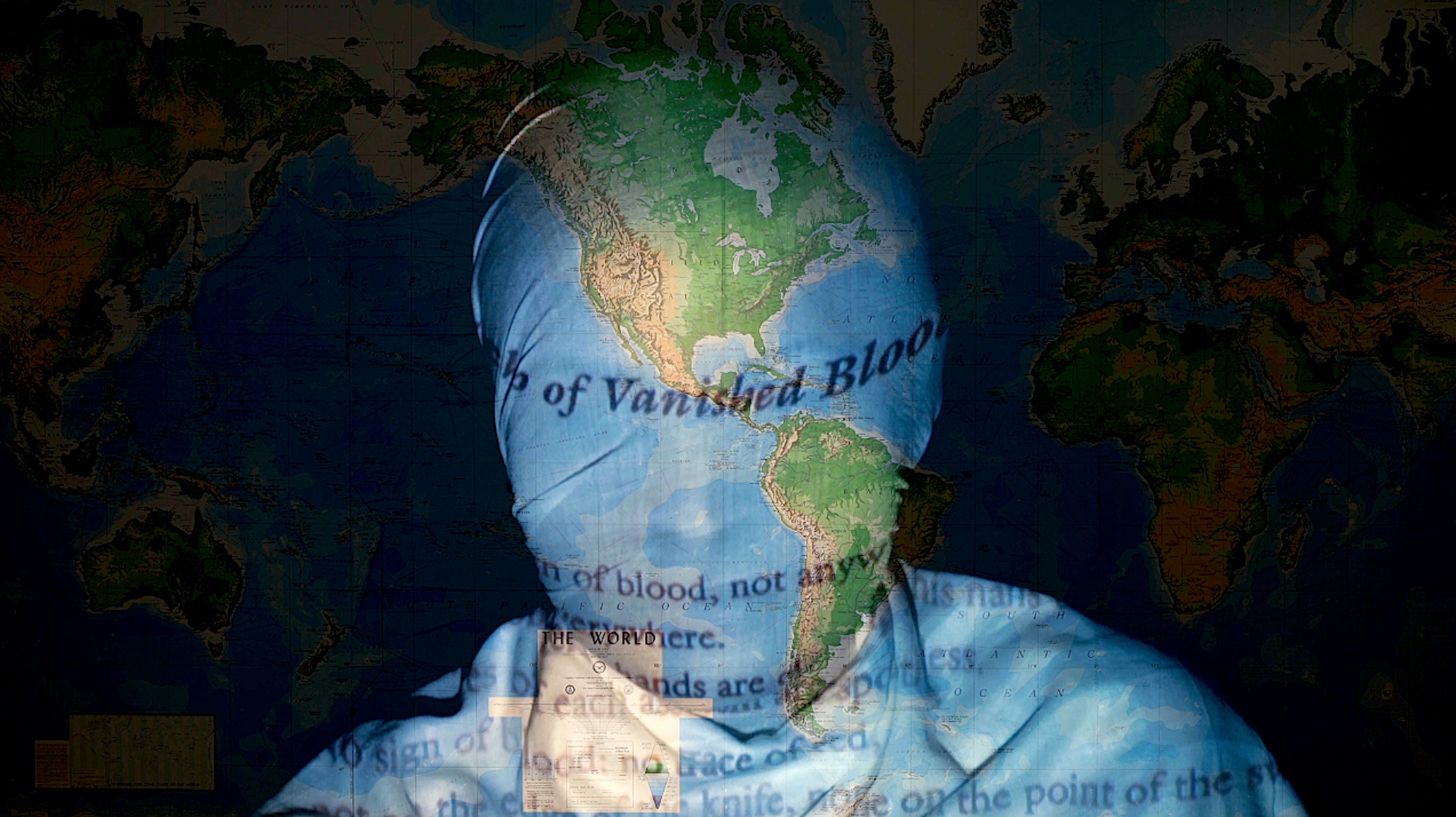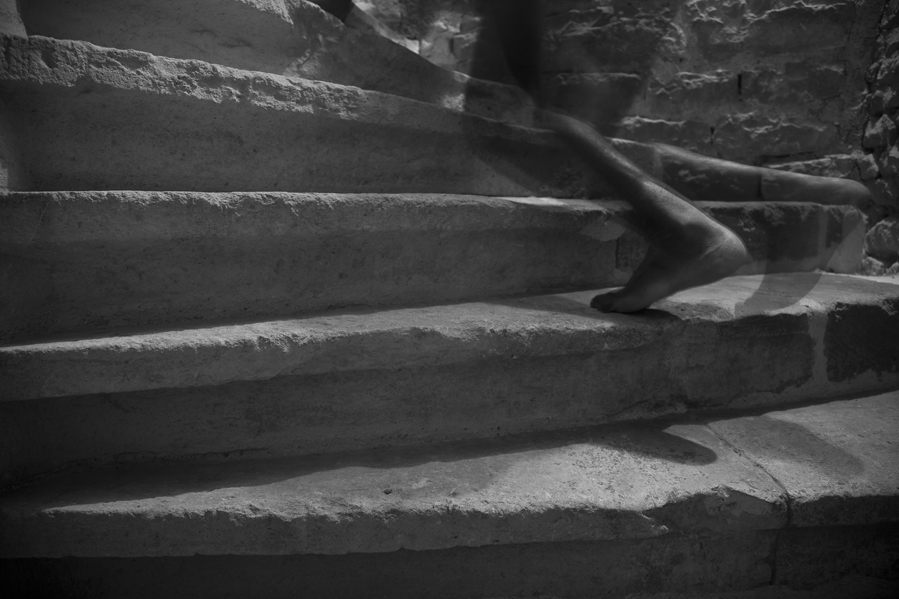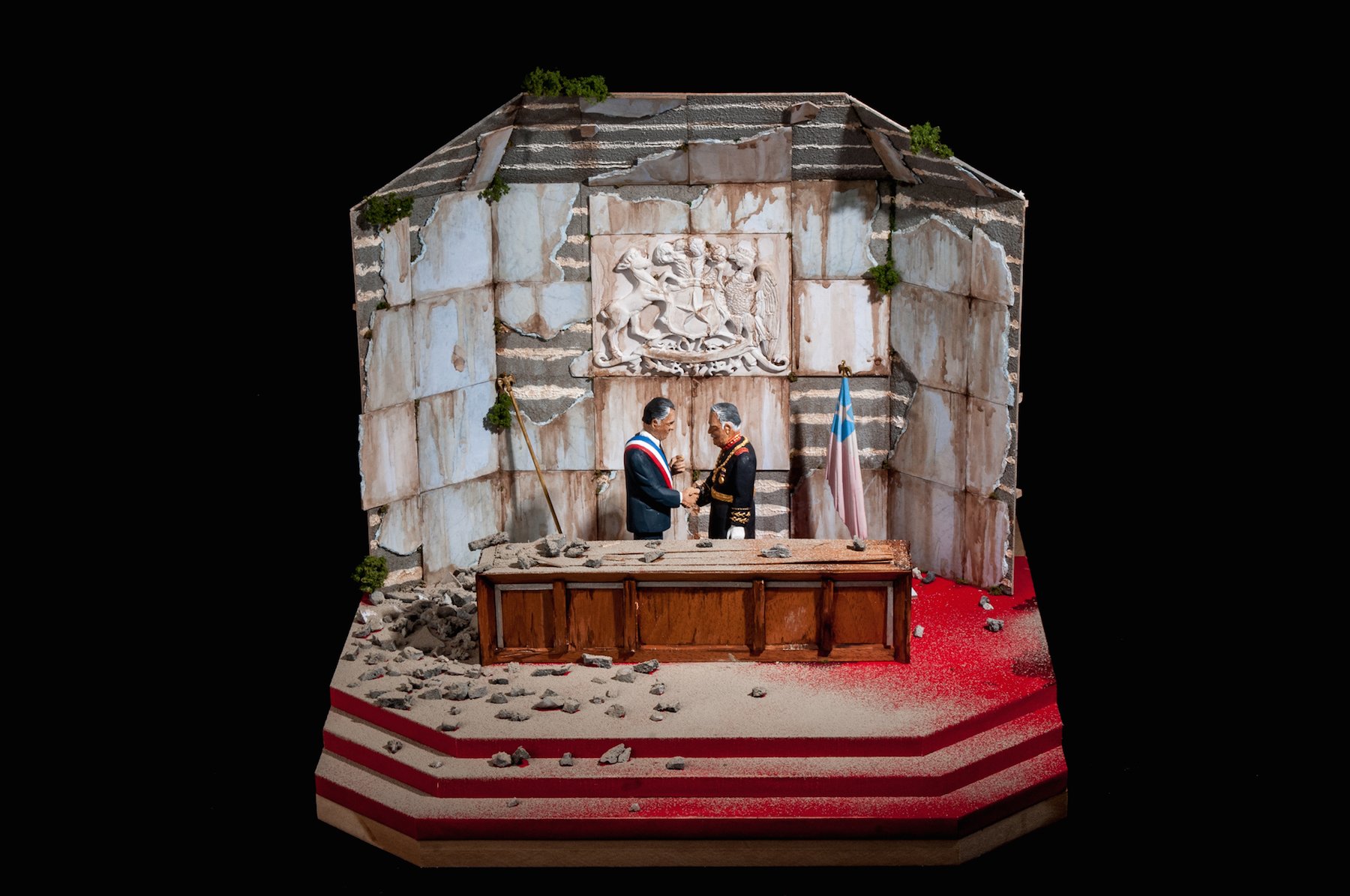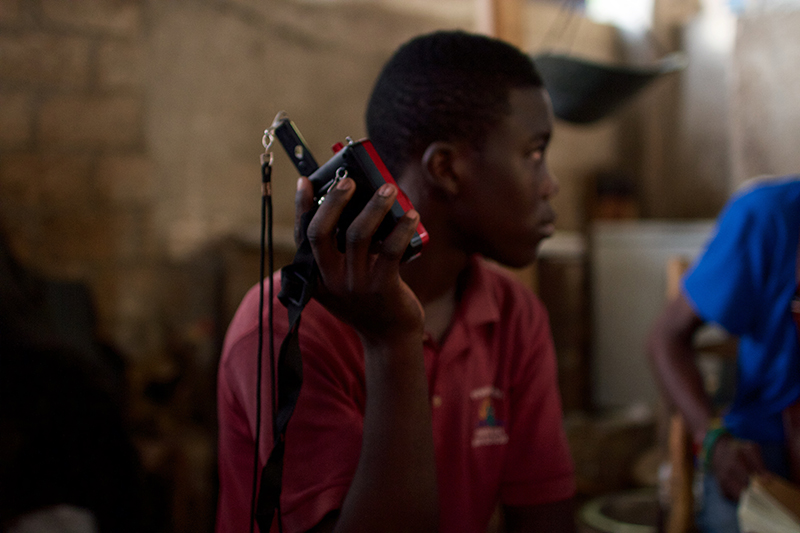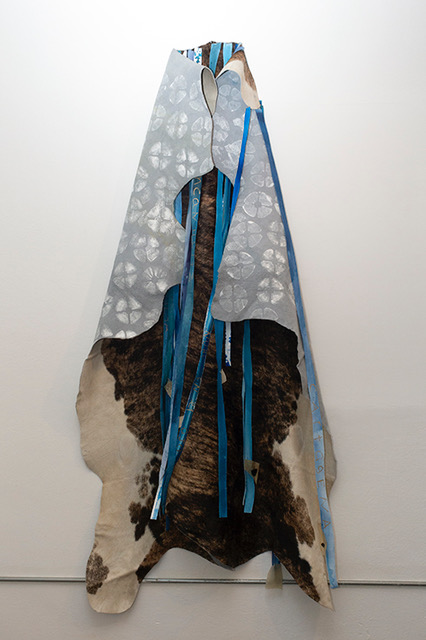
© » KADIST
Jorge González
Easy to fold and carry, Jorge González’s Banquetas Chéveres (Chéveres Stools) embody the nomadic and flexible nature of the Escuela de Oficios. González’s work employs a modernist language while paying homage to artisanal techniques specific to Puerto Rico and the Indigenous knowledge, people, and histories of the Carribean. Reinterpreting the furniture line ArKlu (1945-1948) conceived by the architects Stephen Arneson and Henry Klumb, the stools were conceived in collaboration with various artisans in Puerto Rico–Eustaquio Alers, a weaver from Aguadilla, Joe Hernández from Ciales, and MAOF from San Juan, a contemporary wood-salvaging collective, among others.

© » KADIST
Nidhal Chamekh
Drawing & Print (Drawing & Print)
Nos visages ( Our Faces ) continues Nidhal Chamekh’s research around visual souvenirs of figures of the past and the light they might shed on our contemporary era. For this series of drawings, the artist draws from articles of French colonial propaganda, specifically the magazine Le Miroir , founded in 1910. In these documents Senegalese and Berber “infantrymen” participating in the First World War were represented in a way that situates them “somewhere between the ethnographical survey and the hackneyed colonial and orientalist image” says Morad Montazami.

© » KADIST
Guy Woueté
The video installation Le Fou Postcolonial Insane by Guy Woueté is a series of five videos that examine the concept of insanity in the post-colonial Democratic Republic of Congo. The first three videos in the series were shot in a market place in Lubumbashi, the second largest city in the Congo, where several psychoanalysts explore mental health in the context of the Congolese public sphere. Throughout the video series, Woueté links this public health examination to memories of colonial history.

© » KADIST
Jesse Chun
O (for various skies) by Jesse Chun is a two-channel video sculpture that decentralizes American colonial narratives about the moon through “unlanguaging”—a methodology that the artist has conceptualized for unfixing language. The project disrupts bureaucratic documents pertaining to the United States government’s lunar colonization and militarization, such as The Lunex Project of 1958 and Project Horizon of 1959, through methods of visual, semiotic, and sonic (mis)translation and abstraction. Chun redacts the found texts, transforming them into concrete poetry, while interweaving lesser known Korean folklore about the moon, such as the precolonial Korean women’s moon dance ( ganggangsullae ) and shamanistic ritual dance for ushering the departed into another world ( gildakeum ).

© » KADIST
Frida Orupabo
The archival images used by Frida Orupabo in her collages trace stereotyped representations of race, gender, sexuality and violence. Her works are developed through a process of decontextualization of such imagery, layering and recomposing, playing with new narratives. In this work she focuses on memory and what might be triggered in the viewer.

© » KADIST
Jota Mombaça
Ghost 1: Drowning is not a poem but is not not a poem either by Jota Mombaça is part of a series of sculptures exploring water’s restless, elemental properties and what the artist describes as “the radicality of sinking”. For this project, Mombaça produced three sculptural linen works in collaboration with the waters of the San Francisco Bay (in Berkeley), the San Pablo Bay (in Richmond), and the Pacific Ocean (in Bolinas), wherein the artist submerged linen in these local waters for three to seven weeks, then dried, and installed the materials on metal armatures. Mombaça’s subsequent video waterwill (2023) is composed of various footage from the sinking, floating, and unsinking of these sculptures and those from previous connected performances.

© » KADIST
Sky Hopinka
Dislocation Blues by Sky Hopinka is a portrait of the 2016 Standing Rock protests against the Dakota Access Pipeline in South Dakota. Working against grand narratives and myth-making, Hopinka attempts to provide a clear look towards the participants of the protest movement and the protectors of the water – their testimonies, reflections, and histories. In the film, Cleo Keahna tells about the everyday life of the camp and its difficulties and Terry Running Wild shares his dreams for the future.

© » KADIST
Nikau Hindin
Maori barkcloth making is the central artistic form in the Pacific, and still at the core of cultural expression in many Pacific countries. However, Maori barkcloth making ceased to be practiced in the nineteenth century, at the same time as the arrival of European colonists. Completed barkcloth works often represent another complex Pacific Indigenous accomplishment, the sophisticated system of celestial mapping used in the cross-Pacific navigation that led to the expansion of a vivid pan-Pacific civilisation, thriving before colonial disruption.
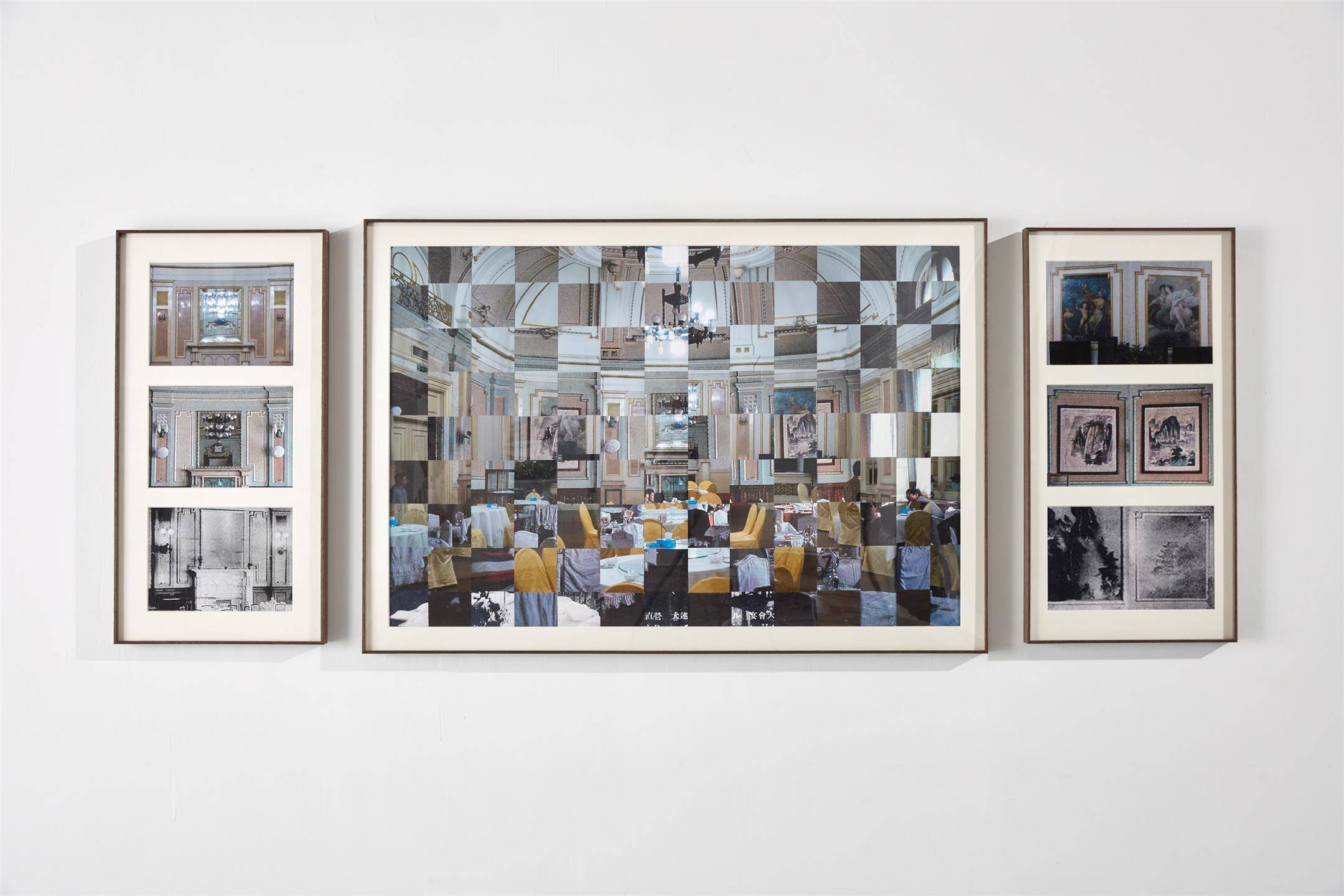
© » KADIST
Luka Yuanyuan Yang
Composed of three photographic panels, Three Times at Yamato Hotel by Luka Yuanyuan Yang is a part of the artist’s ongoing project Dalian Mirage , a seven act play in a theatre staged as the city of Dalian. This modern city was built by the Russian Empire in 1898 and occupied by Japan between 1905 and 1945. Based on historical investigations, Yang created ten characters, including a Dalian-born Japanese writer and a Dalian-born American immigrant.

© » KADIST
Abraham Oghobase
This series of photographs is inspired by the artist’s travels to Jos, Nigeria. Having grown up in the urban environment of Lagos, Abraham Oghobase was struck by the tin-mining deposits and the man-made ponds and lakes that form a dominant part of the landscape in the city of Jos and its surroundings. While visually striking, the landscape also holds a complex history, excavated by the artist, who researched the prevalent mining of tin deposits that dates back to 1904 during the British colonial mineral exploration in the Northern Protectorate.

© » KADIST
Abraham Oghobase
This series of photographs is inspired by the artist’s travels to Jos, Nigeria. Having grown up in the urban environment of Lagos, Abraham Oghobase was struck by the tin-mining deposits and the man-made ponds and lakes that form a dominant part of the landscape in the city of Jos and its surroundings. While visually striking, the landscape also holds a complex history, excavated by the artist, who researched the prevalent mining of tin deposits that dates back to 1904 during the British colonial mineral exploration in the Northern Protectorate.

© » KADIST
Sandra Monterroso
Drawing & Print (Drawing & Print)
Presented as part of a recent group of works titled The Paradox of Healing, Rhombus for Healing No. 2 by Sandra Monterroso brings together several of the artist’s interests: the use of ritual and medicinal elements; the conciliation of Western and indigenous formal languages; and more recently, sewing as a recognition and celebration of her maternal lineage. The series as a whole and this painting in particular continue her interest in textiles as visual references and cultural tools to address her native Guatemala’s complex political and cultural histories.

© » KADIST
Bakudapan Food Study Group
Mooi indie (which translates to “Beautiful Indies”) is a term used to depict the beauty of nature in the East Indies during the period of Dutch colonialism in Indonesia. The term is usually used to describe a painting, romanticising the alluring tropics through the lens of European imperialism. Later in the 1950s, the prominent Indonesian painter S. Sudjojono, who is known as one of the founding fathers of Indonesian Modern Art, publicly rejected the Mooi Indie genre as Indonesian art.

© » KADIST
Pangrok Sulap
Drawing & Print (Drawing & Print)
All Nations are Created Special is a black and white woodcut print by the artist collective Pangrok Sulap. Emblazoned across this fantastical 10 metre long print is the Bahasa Malaysia phrase Semua Bangsa Tercipta Istimewa , which loosely translated means “All Races are Special”. Pangrok Sulap takes the translation one step further, as the title of the work declares “All Nations are Created Special”.

© » KADIST
Noara Quintana
The series Belle Époque of the Tropics by Noara Quintana has as its background the history of the rubber industrialization in North of Brazil. The so-called Amazon Rubber Boom, 1879 to 1912, was an important part of the economic and social history of the country and Amazonian regions of neighboring countries, related to the extraction and commercialization of latex. Centered in the Amazon river basin, the boom resulted in a large expansion of European colonization in the area, causing cultural and social transformations that wreaked havoc upon Indigenous societies and immense environmental damage.

© » KADIST
Mathieu Abonnenc
Secteur IX B is full of ghosts: some that you can see, briefly appearing at the turn of a statue in an under construction museum, some that you only dream of when you switch from day to night, of one space to another. Mathieu Kleyebe Abonnenc invites us to follow a main character, Betty, an ethnographer currently leading research in the archives of the Theodore Monod Museum for African Arts, in Dakar. Punctuated by an anguished soundtrack and borrowing tropes from thriller genre films to create a sense of oddity, the film comments on the contemporary effects of colonial legacy in cultural institutions.

© » KADIST
Abraham Oghobase
This series of photographs is inspired by the artist’s travels to Jos, Nigeria. Having grown up in the urban environment of Lagos, Abraham Oghobase was struck by the tin-mining deposits and the man-made ponds and lakes that form a dominant part of the landscape in the city of Jos and its surroundings. While visually striking, the landscape also holds a complex history, excavated by the artist, who researched the prevalent mining of tin deposits that dates back to 1904 during the British colonial mineral exploration in the Northern Protectorate.

© » KADIST
Santiago Yahuarcani
Drawing & Print (Drawing & Print)
The series Castigos del caucho by Santiago Yahuarcani originates in the oral memory transmitted by the artist’s grandfather, who was a survivor of the Putumayo genocide where thousands of Indigenous people were annihilated and enslaved to extract rubber from the Amazon forest between 1879 and 1912. Yahuarcani’s complex narrative paintings on tree bark highlight a long history of colonial violence against the Uitoto and other Indigenous communities. They also show the destruction of the rainforest under Western models of extraction, privatization, and development.

© » KADIST
Kent Chan
Heat Waves by Kent Chan examines the contexts, politics, and proliferation of the different aesthetics of heat by drawing from the aesthetics of regions defined by hot and humid climates and associated with histories of coloniality such as ‘the global south’ and the ‘developing world’. The video takes the form of a curated broadcast or music video of historical and contemporary imagery and videos of both found and filmed footage, including media broadcasts; TikToks; DJ sets; an interview with Keanu Reeves; an excerpt of Ho Tzu Nyen’s 4 x 4 – Episodes of Singapore Art (2005); an interview with KADIST Collection artist Julian Abraham Togar; and DJ sets. The barrage of footage weaves together contrasting tropes about the tropics: depicting it as a diseased paradise; naturally abundant, yet economically poor; filled with people who are at once energetic and lazy; with dynamic aesthetics, but lacking order.

© » KADIST
Kathy Jetnil-Kijiner
Anointed by Kathy Jetnil-Kijiner and Dan Lin is a poem recital/video that addresses the American nuclear testing legacy in the Marshall Islands that occurred between 1946 to 1958 in Bikini and Enewetak Atolls. The artist’s words of resilience and healing are uttered as she travels across the northeastern atolls of her vast island nation. The climax of the short film takes place when the artist, holding white coral stones (a Marshallese funeral ritual) stands on top of the massive concrete dome erected on Runit Island in Enewetak Atoll to contain 73,000 square meters of radioactive waste—only a small fraction of the debris generated by the nuclear tests, the rest of which was never cleaned up.

© » KADIST
Ghita Skali
The Invaders by Ghita Skali is a tale that bites you. This short film, staged in the first few months of the COVID-19 pandemic, in a broader context of increasingly xenophobic and racist policies in western countries, uses comedy to flip the stigma. First, Skali sets the scene: Once upon a time, a virus came and changed the plan .

© » KADIST
Beatriz Santiago Muñoz
Another curious element is that it seemed that I was seeing images from the dreams I had that afternoon. But these images were appearing from end to beginning, like a film reel running backwards. I also couldn’t properly situate them.

© » KADIST
Fred Wilson
Fred Wilson’s flag paintings document the 20th century history of African people, indexing the period of liberation from colonialism. As the majority of African flags were created during the 1950s and 60s, they were intended to reflect a so-called ‘modern’ aesthetic and ideology. Many African flags maintain the typical flag tropes such as stripes, stars, birds, and blocks of primary and secondary colors; green to represent the land; blue to symbolize the ocean or sky; and red to recall the violence that occured in the pursuit of liberty.

© » KADIST
Kiluanji Kia Henda
Redefining The Power (with Didi Fernandes) is a metaphor of how reflections on history and society during the Angolan Civil War (1975-2002) are largely ignored within the canon of history. Resulting from Kia Henda’s research on the Fortaleza de São Miguel built by the Portuguese in the 15th century in Luanda, Angola, the Redefining The Power series was created 10 years after the Angolan Civil War as a reflection on the reactivation of memory surrounding historical monuments. Through this work, the artist aims to replace the memorialized colonial heroes and war symbols through re-appropriation, determining traumatized lands as forms of resistance and pride.

© » KADIST
Yuyan Wang
The Moon Also Rises by Yuyan Wang comprises a one-channel video and light installation. The work is based on a 2018 initiative in China to launch three artificial moons into orbit above major cities to provide continuous daylight. Set in an oppressively illuminated environment, the images depict lethargic crowds in megacities, surrounded by glowing neon lights, and workers in LED factories performing repetitive tasks on an assembly line in a kind of trance state.

© » KADIST
Ana Vaz
Há Terra! (There Is Land!) is a short film by Ana Vaz that picks up on the artist’s previous film A Idade da Pedra (2013), in which Vaz imagined premodernity in her native Brazil.

© » KADIST
Duane Linklater
silentstar, delicacy by Duane Linklater is a replica of a baby pink hoodie that the artist wore as a teenager, embellished with hand-painted elements and band patches. From associations with punk and hip-hop to skater culture, the hoodie has a history of being adopted by youth-driven communities once relegated to the fringes, and being embraced by mainstream fashion as a practical article of clothing, which Linklater’s work complicates even further. The reproduction is made with dye extracted from cochineal insects.

© » KADIST
Corey McCorkle
Corey McCorkle’s 2016 installation Pendulum is developed around the Cavendish family and their role in importing bananas to Europe. Cavendish bananas were named after William Cavendish, the 6th Duke of Devonshire. In 1834, Cavendish received a shipment of bananas from Mauritius, and developed these bananas in the greenhouses of Chatsworth House with his gardener Sir Joseph Paxton, and were later given to missionary John Williams to take to Samoa.

© » KADIST
Claudia Martínez Garay
escenario chacana by Claudia Martínez Garay is a sculptural work composed of a frame-like structure that contains a series of ceramic pieces. It references the Chakana, an Andean cross that encompasses the different levels of existence (known as Pachas) and sacred elements contained in the Indigenous cosmologies of the region. It often appears in the geometrical motifs of textiles and ceramics.

© » KADIST
Jane Jin Kaisen and Guston Sondin-Kung
The Woman, The Orphan, and The Tiger begins with the sound of women’s voices describing histories of violence, of things repressed and silenced. Gradually, their voices accumulate into a cacophony of pure sonic intensity against an extreme slow-motioned image of a woman survivor of Japan’s military sexual slavery who, in the absence of words to accurately account for her suffering, gets up and walks into the center of a war crimes tribunal court room and gestures wildly before she faints. This work by Jane Jin Kasen and Guston Sondin-Kung explores ways in which trauma is passed on from previous generations to the present through a sense of being haunted.
Abraham Oghobase
Abraham Onoriode Oghobase’s artistic practice explores identity in relation to socio-economic and historic geographies...
Daniela Ortiz
In order to reveal and critique hegemonic structures of power, Daniela Ortiz constructs visual narratives that examine concepts such as nationality, racialization, and social class...
Sancintya Mohini Simpson
Sancintya Mohini Simpson is an artist, writer, and researcher whose work addresses the impact of colonization on the historical and lived experiences of her family and broader diasporic communities...
Trevor Paglen
Trevor Paglen’s work combines the knowledge-base of artist, geographer and activist...
Ana Vaz
Ana Vaz is an artist and filmmaker whose works speculate on the relationships between self and other, and myth and history, through a cosmology of signs, references, and perspectives...
Thu Van Tran
Thu Van Tran grew up in the paradox of the dismantlement of the French colonial empire in Vietnam...
Ghita Skali
Ghita Skali is a visual artist that uses odd news, rumors and propaganda to disrupt institutional power structures such as the western contemporary art world, state oppression and government politics...
Sammy Baloji
Sammy Baloji explores the cultural, architectural and industrial heritage of the Katanga region in Congo...
Carla Zaccagnini
- year born: 1973
- gender: female
- nationality: Brazilian
- home town: Buenos Aires, Argentina
Elyla
Elyla (Fredman Barahona) is a performance artist and queer activist...
Santiago Yahuarcani
Santiago Yahuarcani belongs to the Aimen+ (White Heron) clan of the Uitoto people of the northern Amazon...
Shahzia Sikander
- location: New York
- location: Texas
- year born: 1969
- gender: female
- nationality: Pakistani-American
- home town: Lahore, Pakistan
Yee I-Lann
- location: Kuala Lumpur, Malaysia
- year born: 1971
- gender: female
- nationality: Malaysian
- home town: Sabah, Malaysia
Isadora Neves Marques
The work of writer, visual artist and filmmaker Isadora Neves Marques focuses on the politics of nature, in specific relation to ecology; economics; cultural production; and social and ontological segregation...
Runo Lagomarsino
- location: Malmo, Sweden
- location: Sao Paolo, Brazil
- year born: 1977
- gender: male
- nationality: Italian-Argentine-Swedish
- home town: Sweden
Engel Leonardo
Working with various mediums, from sculpture to installation, site-specific interventions, and readymades, Leonardo Engel addresses issues related to the climate, nature, traditional crafts, architecture, and popular culture of the Caribbean...
Sky Hopinka
Sky Hopinka is from the Ho-Chunk Nation/Pechanga Band of Luiseño Indians...
Musquiqui Chihying
Through his artistic career, Musquiqui Chihying has striven to dislocate and reconstruct established modes of behavior within systems and structures of power...
Frida Orupabo
A central element of Frida Orupabo’s practice is her digital archive, storing images from both the media and from her personal life on her Instagram account, later transforming them into analogue collages...
Duane Linklater
Duane Linklater addresses issues of cultural loss and recovery, as well as appropriation and authorship articulated through sculpture, installation, photography, film, and video...
Matthew Angelo Harrison
Detroit’s Matthew Angelo Harrison works at the intersection of sculpture and technology, building his own 3D printers (which rise to the status of sculpture), and using these creations to formulate others...
Em'kal Eyongakpa
Em’kal Eyongakpa was born in Cameroon in 1981...
Christian Nyampeta
Christian Nyampeta’s works investigate how individuals and communities negotiate forms of socially-organized violence...
Fred Wilson
- location: Bronx, United States
- year born: 1954
- gender: male
- nationality: American
Hong-Kai Wang
Wang is an artist working primarily with sound...
Felipe Arturo
- year born: 1979
- gender: male
- nationality: Colombian
- home town: Bogota, Colombia
Michael Rakowitz
Michael Rakowitz uses the novel charm of everyday things to excite new and oblique approaches to loaded geopolitical subject matter...
Carolina Caycedo
Carolina Caycedo’s work triumphs environmental justice through demonstrations of resistance and solidarity...
Noara Quintana
Noara Quintana’s research-based practice focuses on the materiality of everyday objects and their interconnection with sociopolitical and historical processes in the Global South...
Aubrey Williams
Aubrey Williams was one of the founding members of the Caribbean Artists Movement, formed in the 1960s in the United Kingdom, after settling there in the early 1950s...
-
1970-1979
Aubrey Williams
1972Carib Carnival illustrates Aubrey Willams’s unique artistic language, combining Pre-Columbian iconography with abstraction...
Antonio Ole
1978Antonio Ole’s Rhythm of N’gola Rhythms (1978), is a film about the struggle for Angolan political independence...
-
2000-2009
Tracey Rose
2001“Maqe II” is at first glance a romantic image of three diaphanous angels hovering in the luminous sky over a South African township...
Ahmad Fuad Osman
2007Recollections of Long Lost Memories by Ahmad Fuad Osman is a series of 71 black and white sepia-toned archival photographs that chart, with nostalgia, the social encounters between hierarchies of life in the Malay world...
Fred Wilson
2009Fred Wilson’s flag paintings document the 20th century history of African people, indexing the period of liberation from colonialism...
Joscelyn Gardner
Drawing & Print
2009(Drawing & Print) Creole Portraits III alludes to the 18th century practice by slave women on Caribbean plantations of using tropical plants as natural abortifacients...
-
2010-2019
Jane Jin Kaisen and Guston Sondin-Kung
2010The Woman, The Orphan, and The Tiger begins with the sound of women’s voices describing histories of violence, of things repressed and silenced...
Shahzia Sikander
2010The Last Post was inspired by Sikander’s ongoing interest in the colonial history of the sub-continent and the British opium trade with China...
Kiluanji Kia Henda
2011Redefining The Power (with Didi Fernandes) is a metaphor of how reflections on history and society during the Angolan Civil War (1975-2002) are largely ignored within the canon of history...
Engel Leonardo
2011As with so many other colonized geographies, the ways in which violence has become a natural and expected component of Santo Domingo reflects the forced friendship between the beneficiaries and residues of Modernism...
Hong-Kai Wang
2011The video Music While We Work (2011) is the first part/work of a long-term research project started in 2010...
Nandan Ghiya
2012The Chair (2012) foregrounds media-based tensions between analog and digital imaging technologies as a means of challenging the continued circulation of visual ephemera from India’s colonial past...
Leah Gordon
2012The Caste Portraits Series by Leah Gordon investigates the practice of grading skin color from black to white, which marked the extent of racial mixing in 18th century Haiti...
Ícaro Lira
2012Icaro Lira has been developing the project “Museum of the Foreigner” since 2015, in which he recounts the trajectories of populations inside Brazil, from the north to the big cities of the south...
Tom Nicholson
2012Tom Nicholson’s Comparative Monument (Palestine) engages a peculiar Australian monumental tradition: war monuments that bear the name “Palestine”...
Felipe Arturo
2012Defined as entropy, the second law of thermodynamics proposes that energy is more easily dispersed than it is concentrated...
Nalini Malani
2012Malani draws upon her personal experience of the violent legacy of colonialism and de-colonization in India in this personal narrative that was shown as a colossal six channel video installation at dOCUMENTA (13), but is here adapted to single channel...
Beatriz Santiago Muñoz
2013Another curious element is that it seemed that I was seeing images from the dreams I had that afternoon...
Rometti Costales
2013This anarchist flag is made from Huayruro seeds, a native plant of South and Central American tropical areas...
Daniela Ortiz
2013Previously, Ortiz produced a series of photographs related to her research on the position of ‘service architecture’, the vital space given to domestic servants in the modernist architectural houses of South American upper class families...
Yee I-Lann
2013Sarcastically titled to call attention to the problematic notions underlying colonialism, this photograph shows hundreds of Native Malaysians seated quietly behind one of their colonial oppressors...
Thu Van Tran
2014From Green to Orange is a series of silver films immersed in a bath of dye and rust...
Nicolás Grum
2014El gran pacto de Chile (The Great Pact) and La balserita de Puerto Gala (The Raft) were part of the “Museo Futuro”, an exhibition in which the artist presented nine miniature dioramas staging fragments of Chile’s history, from its colonial invasions to the present...
Khvay Samnang
2014The video Rubber Man continues exploring issues related to land use, also noticeable in his Untitled series (2011)...
Nicolás Grum
2014El gran pacto de Chile (The Great Pact) and La balserita de Puerto Gala (The Raft) were part of the “Museo Futuro”, an exhibition in which the artist presented nine miniature dioramas staging fragments of Chile’s history, from its colonial invasions to the present...
Ximena Garrido Lecca
2014Destilaciones ( Distillations , 2014) is an installation composed of a group of ceramic pots, presented on the floor and within a steel structure...
Hank Willis Thomas
2014South Africa Righteous Space by Hank Willis Thomas is concerned with history and identity, with the way race and ‘blackness’ has not only been informed but deliberately shaped and constructed by various forces – first through colonialism and slavery, and more recently through mass media and advertising – and reminds us of the financial and economic stakes that have always been involved in representations of race....
Mathieu Abonnenc
2015Secteur IX B is full of ghosts: some that you can see, briefly appearing at the turn of a statue in an under construction museum, some that you only dream of when you switch from day to night, of one space to another...
Gaëlle Choisne
2015Entre Chien et Loup is an installation incorporating a variety of media: rubber, discs, feathers and confetti that the artist weaves, sews and glues together...
Beatriz Santiago Muñoz
2015Marché Salomon by Beatriz Santiago Muñoz depicts two meat vendors, a young man and woman, chatting in Marché Salomon, a busy Port-au-Prince market...
Naufus Ramírez-Figueroa
2015Naufus Ramírez-Figueroa’s performance Illusion of Matter establishes a dream state through a composition of motifs that were drawn from the artist’s childhood memories...
Naresh Kumar
Drawing & Print
2015(Drawing & Print) “Relation between Black and blood” explores the connection between performance, installation and representation...
Newell Harry
2015(Untitled) Nimoa and Me: Kiriwina Notations by Newell Harry brings together a litany of contemporary politics—mobilization around enduring racism, the legacies of Indigenous and independence struggle, and the prospects of global solidarity against neocolonialism and social injustice...
Carolina Caycedo
2015Carolina Caycedo’s practice conveys her very personal passion and relationship to water, as a powerful necessity and spiritual reminder...
Matthew Angelo Harrison
2015In Hole #1 a zebra scull stands in as a representation of Africa, while the plexiglass box and the hole made through it represent the inaccessibility of that culture to African-Americans....
Corey McCorkle
2016Corey McCorkle’s 2016 installation Pendulum is developed around the Cavendish family and their role in importing bananas to Europe...
Isadora Neves Marques
2016The Pudic Relation between Machine and Plant shows a looped scene where a robotic hand touches a “sensitive plant” — Mimosa Pudica, a species characteristic for closing on itself when touched...
Nohemí Pérez
Drawing & Print
2016(Drawing & Print) A rich and isolated region, El Catatumbo is located near the border with Venezuela...
Jorge González
2017Easy to fold and carry, Jorge González’s Banquetas Chéveres (Chéveres Stools) embody the nomadic and flexible nature of the Escuela de Oficios...
Sky Hopinka
2017Dislocation Blues by Sky Hopinka is a portrait of the 2016 Standing Rock protests against the Dakota Access Pipeline in South Dakota...
Santiago Yahuarcani
Drawing & Print
2017(Drawing & Print) The series Castigos del caucho by Santiago Yahuarcani originates in the oral memory transmitted by the artist’s grandfather, who was a survivor of the Putumayo genocide where thousands of Indigenous people were annihilated and enslaved to extract rubber from the Amazon forest between 1879 and 1912...
Bady Dalloul
Drawing & Print
2017(Drawing & Print) The Great Game is a series of works composed of a number of card combinations illustrated by the faces of key political figures shaping the geopolitical landscape in the Middle East...
Ali Cherri
2017As a discipline born at the same time as colonialism, archeology is struggling to rid itself of this sad context...
Daniel Boyd
2017Daniel Boyd’s work WTEIA3 is part of a series of paintings that reference the stick charts used by indigenous communities on the Marshall Islands...
Michael Rakowitz
2017The Ballad of Special Ops Cody by Michael Rakowitz is a serio-comic stop motion animated film in which an everyday African-American G...
Danielle Dean
2017In True Red Ruin (Elmina Castle) , Danielle Dean uses archival documents to re-imagine colonial history from the 1400s, while also referencing her own personal history...
Antonio Pichillá
2017Wind by Antonio Pichillá is a textile piece depicting the glyph that represents the element wind in the Mayan tradition...
Frida Orupabo
2018The archival images used by Frida Orupabo in her collages trace stereotyped representations of race, gender, sexuality and violence...
Abraham Oghobase
2018This series of photographs is inspired by the artist’s travels to Jos, Nigeria...
Abraham Oghobase
2018This series of photographs is inspired by the artist’s travels to Jos, Nigeria...
Bakudapan Food Study Group
2018Mooi indie (which translates to “Beautiful Indies”) is a term used to depict the beauty of nature in the East Indies during the period of Dutch colonialism in Indonesia...
Abraham Oghobase
2018This series of photographs is inspired by the artist’s travels to Jos, Nigeria...
Kathy Jetnil-Kijiner
2018Anointed by Kathy Jetnil-Kijiner and Dan Lin is a poem recital/video that addresses the American nuclear testing legacy in the Marshall Islands that occurred between 1946 to 1958 in Bikini and Enewetak Atolls...
Juan Brenner
2018The photographic series Tonatiuh (The Son of the Sun) by Juan Brenner is an in-depth visual study of current Guatemalan society from the perspective of miscegenation and the incalculable consequences of the Spanish conquest...
Fabien Giraud & Raphael Siboni
2018– In which an intelligence going back to its place of origin discovers the agony of gods on which it thrives – Seventh and last episode of The Unmanned , “a flood” is set in 1542 as the first conquistadors enter the land later to be known as the Silicon Valley...
Bayrol Jiménez
2018Sombras de los Valles (Shadows of the Valleys) is part of a series of works created by Bayrol Jiménez in which he is influenced by hand-painted signs and large billboards in Mexico...
Jota Mombaça
2018The performance title A Gente Combinamos De Não Morrer (BANDEIRA #1) / Us Agreed Not To Die (FLAG #1) is taken from a short story by Brazilian writer Conceição Evaristo, whose work addresses violence, resilience, and necropolitics with an Afro-diasporic lens...
Nadia Myre
2018First exhibited as part of the recent multidisciplinary project Code Switching and Other Work , at Art Mûr, Berlin in late 2018, Nadia Myre’s Untitled (Tobacco Barrel) takes inspiration from the cylindrical vessels used to import tobacco from North America to Europe during periods of early colonial settlement...
Sofía Córdova
2018dawn chorus ii: el niagara en bicicleta is a work produced in Sofía Córdova native Puerto Rico and was largely shaped by the financial crisis, the islands’ histories under colonial rule and most recently, the climate-change related natural disasters which have affected the island...
Karrabing Film Collective
2018The Mermaids, or Aiden in Wonderland by Karrabing Film Collective is a surreal exploration of Western toxic contamination, capitalism, and human and non-human life...
Abraham Oghobase
2018This series of photographs is inspired by the artist’s travels to Jos, Nigeria...
Gary-Ross Pastrana
2018Gary-Ross Pastrana’s video installation Rewilding consists of three large-scale projections placed across the exhibition space...
Christian Nyampeta
2018The film Sometimes It Was Beautiful by Christian Nyampeta poetically addresses the systemic conditions leading and emerging from the 1994 Rwandan genocide, which had lasting and profound effects on Rwanda and neighbouring countries like Congo...
Carla Zaccagnini
2018De sino à sina (From Bell to Fate) is a six-channel sound installation by Carla Zaccagnini exploring the relationship between modern Brazil and its colonial past...
Cian Dayrit
2018Yuta Nagi Panaad (Promised Land) by Cian Dayrit addresses the impacts of the globalized economy and its powerful ideology on the spaces of everyday life...
Dale Harding
2018Dale Harding’s installation Body of Objects consists of eleven sculptural works that the artist based on imagery found at sandstone sites across Carnarvon Gorge in Central Queensland...
Nidhal Chamekh
Drawing & Print
2019(Drawing & Print) Nos visages ( Our Faces ) continues Nidhal Chamekh’s research around visual souvenirs of figures of the past and the light they might shed on our contemporary era...
Guy Woueté
2019The video installation Le Fou Postcolonial Insane by Guy Woueté is a series of five videos that examine the concept of insanity in the post-colonial Democratic Republic of Congo...
Luka Yuanyuan Yang
2019Composed of three photographic panels, Three Times at Yamato Hotel by Luka Yuanyuan Yang is a part of the artist’s ongoing project Dalian Mirage , a seven act play in a theatre staged as the city of Dalian...
Noara Quintana
2019The series Belle Époque of the Tropics by Noara Quintana has as its background the history of the rubber industrialization in North of Brazil...
Claudia Martínez Garay
2019escenario chacana by Claudia Martínez Garay is a sculptural work composed of a frame-like structure that contains a series of ceramic pieces...
Natalia Lassalle-Morillo
2019In her film Retiro (2019), Natalia Lassalle-Morillo considers how women pass down memories to their kin as they age...
Musquiqui Chihying and Gregor Kasper
2019Addressing the legacy of colonialism, The Guestbook by Musquiqui Chihying and Gregor Kasper is a slow-paced, black-and-white film exploring the German colony of Togoland, now the Republic of Togo...
Noé Martínez
2019As he investigates the forms that slavery took through different events that occurred during the sixteenth century in the Huasteca region of Mexico, Noé Martínez tells, in a non-linear narrative, the history of human trafficking in Relación de tráfico de personas 1525-1533 I (Study of Trafficking of Persons 1525–1533 I) ...
Musquiqui Chihying
2019The Sculpture by Musquiqui Chihying comprises a two-channel lecture performance and a photograph...
Shubigi Rao
2019Named after a book that artist Shubigi Rao read growing up, The Yellow Scarf explores the history of the Thuggee cult in India in relation to the colonial British administration that ‘discovered’ but also ultimately exterminated this cult of assassins...
Karla Dickens
2019Karla Dickens’s collage Beneath the skim board addresses issues of discrimination and racism towards Indigenous communities in Australia through a constellation of historical and current events...
Vvzela Kook
2019Columbus of Horticulture stems from Vvzela Kook’s ongoing research into the central and often-ignored role that botany played in the history of European imperialism...
Sancintya Mohini Simpson
Drawing & Print
2019(Drawing & Print) And words were whispered by Sancintya Mohini Simpson is a series of ten works on paper based on the lived experiences of Indian women taken to the Natal region of South Africa from the 1860s to the early 1900s to work in tea and sugarcane plantations during apartheid, which included servitude in its broadest and most sinister definition...
-
2020-2029
Duane Linklater
2020silentstar, delicacy by Duane Linklater is a replica of a baby pink hoodie that the artist wore as a teenager, embellished with hand-painted elements and band patches...
Caroline Déodat
2020Landslides is a cinematographic essay/poem by Caroline Déodat in which fictional images are the result of research into the memories of a Mauritian dance born during colonial slavery, the Sega...
Trevor Paglen
2020The Black Canyon Deep Semantic Image Segments by Trevor Paglen merges traditional American landscape photography (sometimes referred as ‘frontier photography’ for sites located in the American West) with artificial intelligence and other technological advances such as computer vision...
Trevor Paglen
2020Half Dome Hough Transform by Trevor Paglen merges traditional American landscape photography (sometimes referred as ‘frontier photography’ for sites located in the American West) with artificial intelligence and other technological advances such as computer vision...
Runo Lagomarsino
2020Yo también soy humo (I am also smoke) is a 16mm film that has been digitized to video...
Jesse Chun
2021O (for various skies) by Jesse Chun is a two-channel video sculpture that decentralizes American colonial narratives about the moon through “unlanguaging”—a methodology that the artist has conceptualized for unfixing language...
Nikau Hindin
2021Maori barkcloth making is the central artistic form in the Pacific, and still at the core of cultural expression in many Pacific countries...
Pangrok Sulap
Drawing & Print
2021(Drawing & Print) All Nations are Created Special is a black and white woodcut print by the artist collective Pangrok Sulap...
Kent Chan
2021Heat Waves by Kent Chan examines the contexts, politics, and proliferation of the different aesthetics of heat by drawing from the aesthetics of regions defined by hot and humid climates and associated with histories of coloniality such as ‘the global south’ and the ‘developing world’...
Sancintya Mohini Simpson
2021Dhuwã (term used by indentured people of Natal for ‘smoke’), is a single-channel film by Sancintya Mohini Simpson that traces back to the lived experiences of indentured labourers taken from India to Natal (now KwaZulu-Natal, South Africa) to work on sugar plantations during the late 1800s and early 1900s...
Daniela Ortiz
2021The Rebellion of Roots by Daniela Ortiz depicts a series of situations in which tropical plants, held hostage in the botanical gardens and greenhouses of Europe, are protected and nurtured by the spirits of racialized people who died as a result of European racism...
Jota Mombaça
2022Ghost 1: Drowning is not a poem but is not not a poem either by Jota Mombaça is part of a series of sculptures exploring water’s restless, elemental properties and what the artist describes as “the radicality of sinking”...
Yuyan Wang
2022The Moon Also Rises by Yuyan Wang comprises a one-channel video and light installation...
Richard Bell
2022For Richard Bell, art is not simply a vehicle through which to represent and convey political content...
Michelle and Noel Keserwany
2022Les Chenilles by Michelle and Noël Keserwany is a sensual film that translates the source of women’s oppression into the means for their liberation...
Ana Vaz
2022Ana Vaz describes her film É Noite na América (It is Night in America) as an eco-terror tale, freely inspired by A cosmopolitics of animals by Brazilian philosopher Juliana Fausto; in which she investigates the political life of non-human beings and questions the modern idea of the exceptionality of the human species...
Sandra Monterroso
Drawing & Print
2023(Drawing & Print) Presented as part of a recent group of works titled The Paradox of Healing, Rhombus for Healing No...



